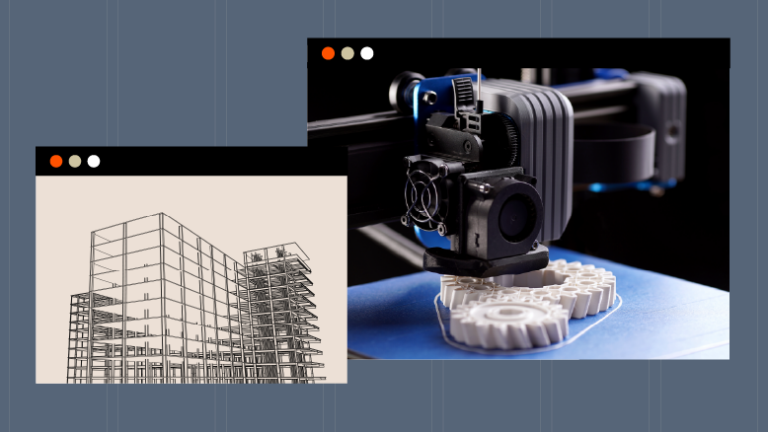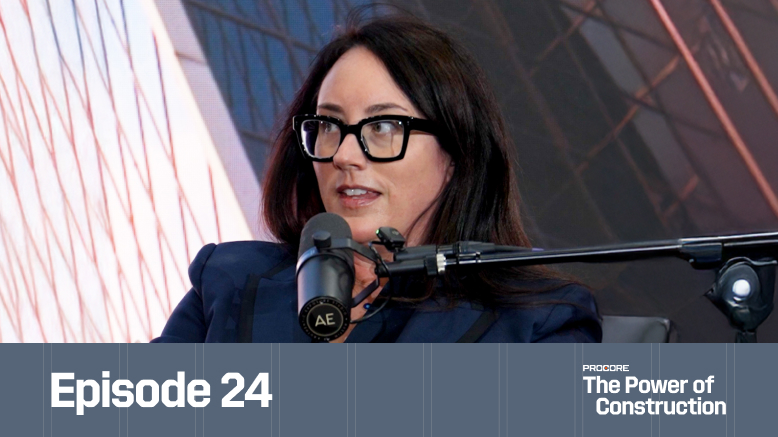— 7 min read
From Digital to Reality: Combining BIM and 3D Printing for Construction

Last Updated Sep 23, 2025

Kacie Goff
Contributing Writer
87 articles
Kacie Goff is a construction writer who grew up in a construction family — her dad owned a concrete company. Over the last decade, she’s blended that experience with her writing expertise to create content for the Construction Progress Coalition, Newsweek, CNET, and others. She founded and runs her own agency, Jot Content, from her home in Ventura, California.
Last Updated Sep 23, 2025

Using building information modeling (BIM) enables more thorough planning, constructability checks, informed stakeholder collaboration and more. As a result, it delivers faster, more cost-efficient, safer construction projects.
To date, BIM has faced one major challenge: While the model can be a highly valuable planning tool, teams have struggled to deploy it in the field. New technologies supported by augmented reality (AR) can help here, but contractors still have to translate the digital model to the real world.
But with the use of 3D printing, that could all change — at least for certain pieces of the construction process. To understand the full potential of this approach, let's take a look at how construction professionals utilize 3D printing and how it can pair with BIM for project success.
Table of contents
The Basics of 3D Printing in Construction
3D printing, also called additive manufacturing, uses specialized machinery to construct tangible 3D elements. The printer essentially slices the element into 2D layers, then creates the element by printing each layer individually, with one stacked on top of the other. For people not familiar with how this works, the explainer video from Mashable can help.
Today, some of the most commonly used 3D printing methods include:
- Fused filament fabrication (FFF), which entails feeding a plastic filament through a heated nozzle
- Stereolithography (SLA), which prints liquid resin, then cures it with a laser to harden it
- Selective laser sintering (SLS), which starts with a powdered material that gets formed into the solid printed element
As this technology becomes increasingly used in construction, innovative, large-scale 3D printers can be used to print with concrete, metal and other materials. For example, arc additive manufacturing (WAAM) uses a 3D printer to weld layers of metal to create a metallic element. And teams have scaled up even further from there: With huge gantry lift or robotic arm-based printers, some construction teams are even printing entire structures.
Construction teams can use 3D printing in a variety of ways to make daily life and projects as a whole easier. That includes 3D printing:
- Tangible scaled-down models to bring to owner meetings helping them visualize the project
- Prototypes to allow for the testing of scaled-down components
- Individual elements needed for the project
- Entire structures, from apartments to municipal buildings to full-scale coffee shops
With so many different uses for this technology, it looks like the construction industry is only in the early stages of adoption. Experts predict a lot of growth in this area in the coming years. Specifically, the global 3D printing construction market is expected to see a compound annual growth rate of 153% between 2025 and 2033.
Using BIM To Power 3D Printing
BIM helps construction professionals “build” the project digitally, allowing them to identify and address problems there. This way, once work starts happening on the jobsite, contractors have fewer surprises to contend with and more information to guide their path forward.
Still, BIM leaves room for human interpretation and, as a result, human error. Connecting the model to a 3D printer skips that step, allowing data to flow directly from the model to the real world. As a result, what gets printed should be an exact replica of what’s been modeled. Provided stakeholders have done the work of validating the model, which allows for ultra-precise construction.
As any construction professional can likely guess, it’s not that simple. As of yet, BIM authoring platforms don’t necessarily have plug-and-play functionality with 3D printers. Plus, 3D printing introduces a range of special considerations, from joint composition and void positioning to printing route optimization.
As a result, to use a BIM model to 3D print, companies need employees with specific areas of expertise. For starters, they will need to turn to someone to convert the model to the appropriate file type for the 3D printer (e.g., an SLA file for stereolithography).
Experts in this area have begun proposing frameworks for the way information should flow from the model to a 3D printer and, consequently, into the real world. As the integration of BIM and 3D printing is fairly new, though, teams will need to develop their own processes for leveraging model data to drive their 3D printer(s).
Benefits of Integrating BIM and 3D Printing Technology
Deploying 3D printing and BIM together can come with some notable advantages.
u003cstrongu003eSustainabilityu003c/strongu003e
The precision gained from feeding a well-planned BIM model directly to a 3D printer eliminates a lot of the waste that’s common on jobsites. Plus, researchers are exploring ways to print construction materials that have a lower environmental impact. Teams at the University of Virginia are working on a 3D-printable concrete alternative that comes from wood pulp. Similarly, a town in Texas is printing houses with a near-zero-carbon cement mixture.
u003cstrongu003eFaster Progressu003c/strongu003e
Combining BIM and 3D printing allows for the real-world prototyping of quickly made elements. This can help engineers solve problems faster. And with 3D printing guided by the model, printers can run 24 hours a day, continually driving the project forward. And these printers can work fast. In some cases, teams are printing entire houses in as little as 24 hours.
u003cstrongu003eLabor Cost Savingsu003c/strongu003e
The 3D printers used in construction don’t run fully autonomously. They need oversight from a human, and might require workers onsite to cut holes for openings and utilities before the printed material hardens. Still, the 3D printing technology does a lot of the work required to create components or erect structures. This can be a huge boon to construction companies during industry-wide labor shortages.
u003cstrongu003eAttracting New Talentu003c/strongu003e
Using exciting and leading-edge technologies like BIM and 3D printing might attract younger, tech-native workers to the industry, further helping to alleviate the labor shortage.
Easier u003cstrongu003eOff-site Prefabricationu003c/strongu003e
When the project is thoroughly coordinated in the model, teams can confidently fabricate elements off-site, knowing they will fit. With a 3D printer in play, that fabrication can get faster and less labor-intensive.
Precise u003cstrongu003eCustom and Elementsu003c/strongu003e
3D printers can create components with complicated geometries. Curved edges are notoriously difficult to achieve with traditional construction methods. A 3D printer, though, can create them with ease. With the BIM model in play, teams can rest easy knowing those more complex elements should fit seamlessly with the rest of the project.
Challenges When Using BIM and 3D Printing
Using these sophisticated technologies isn’t without its difficulties. Some of the biggest obstacles in combining 3D printing and BIM include:
u003cstrongu003eTechnical Expertiseu003c/strongu003e
3D printing is fairly new in the construction industry. Some construction companies are just now getting their feet wet with BIM, too. As a result, stakeholders who have the required level of expertise to take the model files and convert them to a format for the 3D printer are currently scarce.
u003cstrongu003eLack of Building Codes or Regulatory Guidanceu003c/strongu003e
Building codes are specifically designed to help teams create safe, high-quality structures. They often assume, though, that a lot of traditional construction methods will be used. 3D printing falls well outside many of those methods. As a result, code compliance can be tricky. This is enough to slow industry-wide adoption.
Technologial Limitations
3D printing can only do so much. It can’t, for example, easily print an overhang without some sort of support for the overhang while the material hardens. This makes some elements in the model challenging or even impossible to print. Scale is also an issue here. With a gantry system for 3D printing, for example, the system needs to be larger than the structure being printed. Building out the infrastructure for that eats into the gains realized with this kind of technology.
Free AI in Construction Course with Hugh Seaton
Start learning today with industry expert Hugh Seaton and discover how AI can boost efficiency, reduce risk, and transform your projects.

How BIM and 3D Printing Could (Literally) Shape the Future of Construction
BIM isn’t new in construction, but many companies certainly still haven’t adopted it wholesale. 3D printing in construction is still very novel. Using these two technologies together is absolutely in its early days.
If usage ticks up — as many expect thanks to the benefits on offer here — BIM and 3D printing will transform the construction industry. Teams will unlock a way to fabricate unique parts based on each project’s specific needs. 3D printing will allow the well-planned data in the BIM model to flow directly into the real world with minimal human labor. Greener materials may get easier to use, too, replacing climate-burdening options like cement.
BIM and 3D printing technologies don’t just have the potential to change the way construction works, either. They may also change how it looks when completed. As a 3D-printed bridge in Amsterdam highlights, using BIM and 3D printers can unlock a whole new world of complex and curved elements.
In short, combining 3D printing and BIM together may change the lives of not just construction professionals, but every person who sets eyes on a completed structure in which these technologies were used.
Was this article helpful?
Thank you for your submission.
0%
0%
You voted that this article was . Was this a mistake? If so, change your vote
Scroll less, learn more about construction.
Subscribe to The Blueprint, Procore’s construction newsletter, to get content from industry experts delivered straight to your inbox.
By clicking this button, you agree to our Privacy Notice and Terms of Service.
Thank you!
You’re signed up to receive The Blueprint newsletter from Procore. You can unsubscribe at any time.
Categories:
Written by

Kacie Goff
Contributing Writer | Procore Technologies
87 articles
Kacie Goff is a construction writer who grew up in a construction family — her dad owned a concrete company. Over the last decade, she’s blended that experience with her writing expertise to create content for the Construction Progress Coalition, Newsweek, CNET, and others. She founded and runs her own agency, Jot Content, from her home in Ventura, California.
View profileExplore more helpful resources

How Are Partnerships in Construction Being Redefined?
In a market where cost, speed, and quality are table stakes, owners are demanding more than projects delivered on time and on budget. They want trusted partners who bring strategy,...

How Close Are We to Bridging the Design-Build Divide?
For decades, construction decisions have often been made based on gut instinct. But what if the real barrier to transformation isn’t technology—it’s the divide between design and construction? In episode...

Will AI Replace ‘Paperless Builders’—or Redefine Them?
How can artificial intelligence enhance rather than replace human expertise in construction? In Episode 16, Hamzah Shanbari, Director of Innovation at Haskell and author of “The Paperless Builders,” reveals how...

Building Intelligence: How AI & Data Are Rewiring Construction for the Digital Age
As data center construction surges to meet the demands of AI, cloud computing, weekend streaming binges and real-time digital services, the pressure being put on builders by owners has reached...
Free Tools
Calculators
Use our calculators to estimate the cost of construction materials for your next project.
Templates
Find a template to help you with your construction project tasks.
Material Price Tracker
Get the latest U.S. retail prices and view historical trends for common building materials.
Glossary
Explore key terms and phrases used in the industry.
